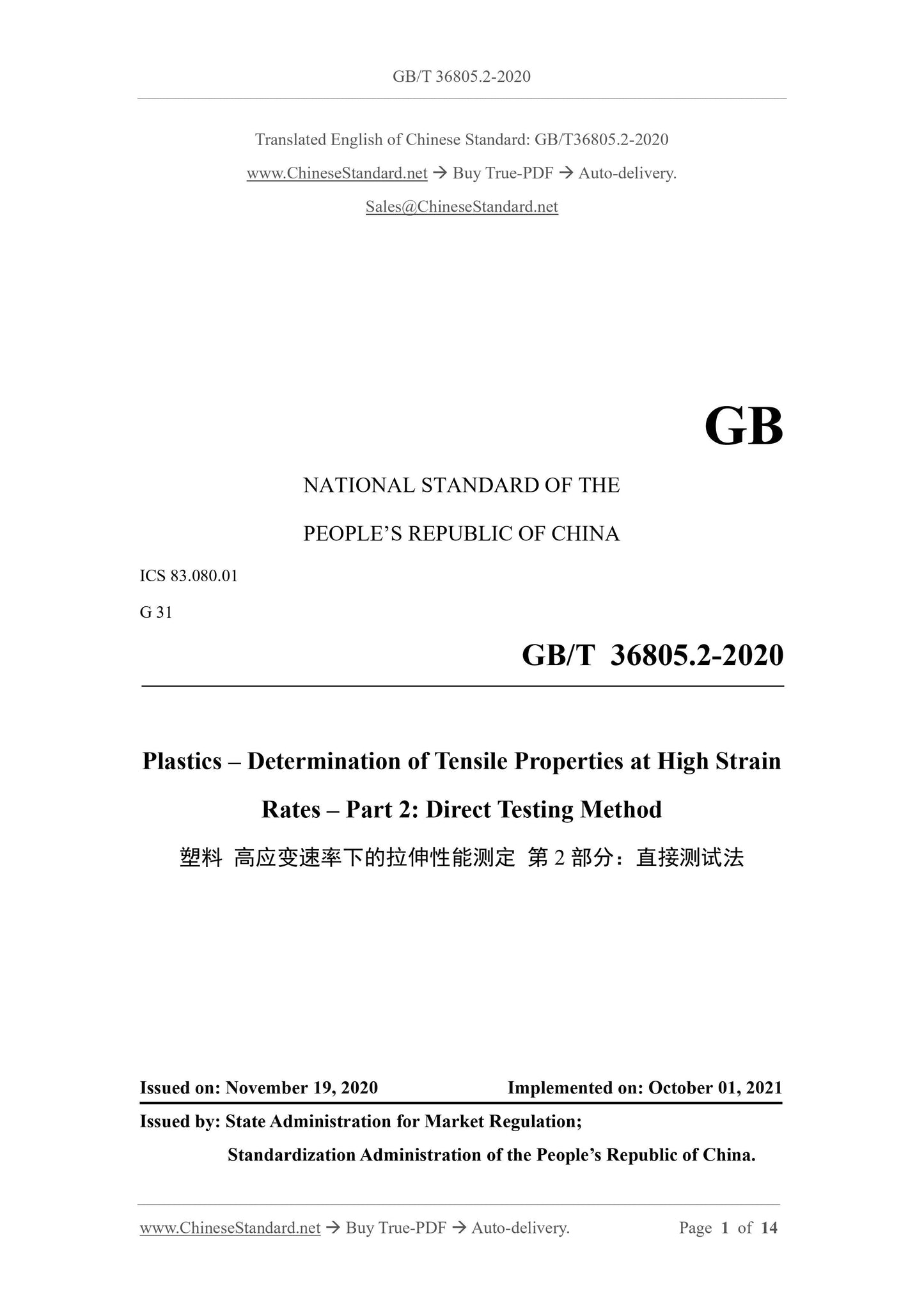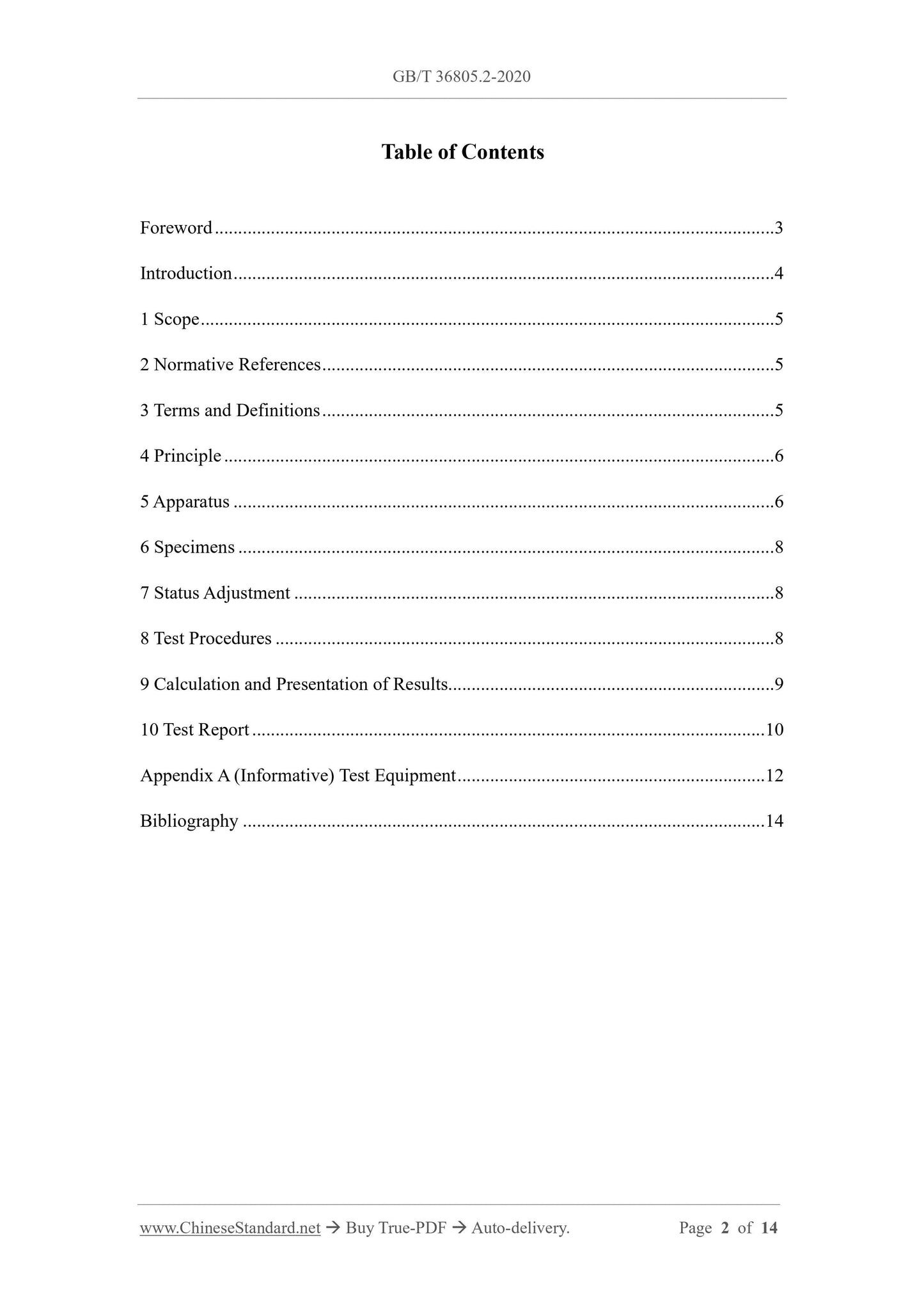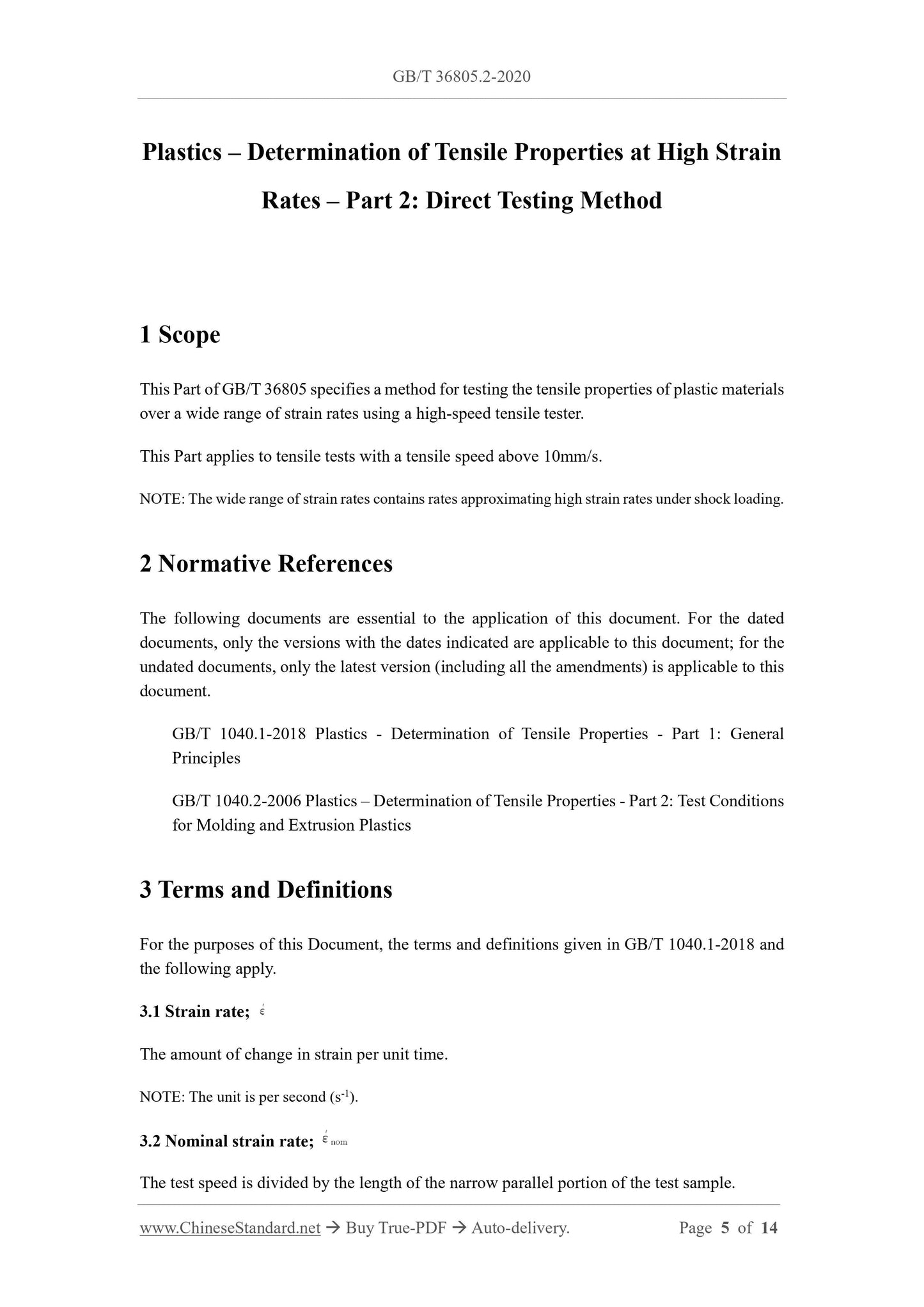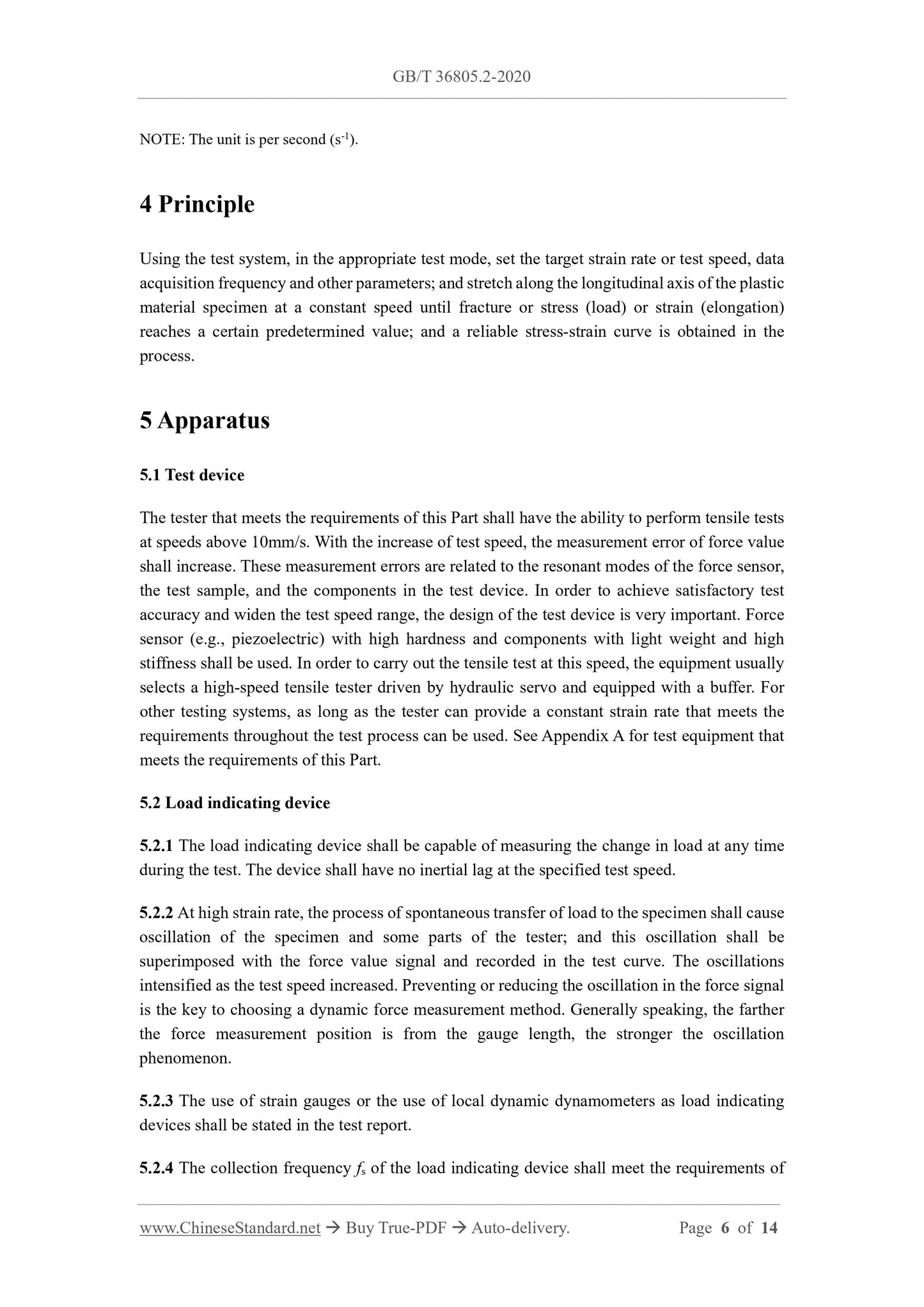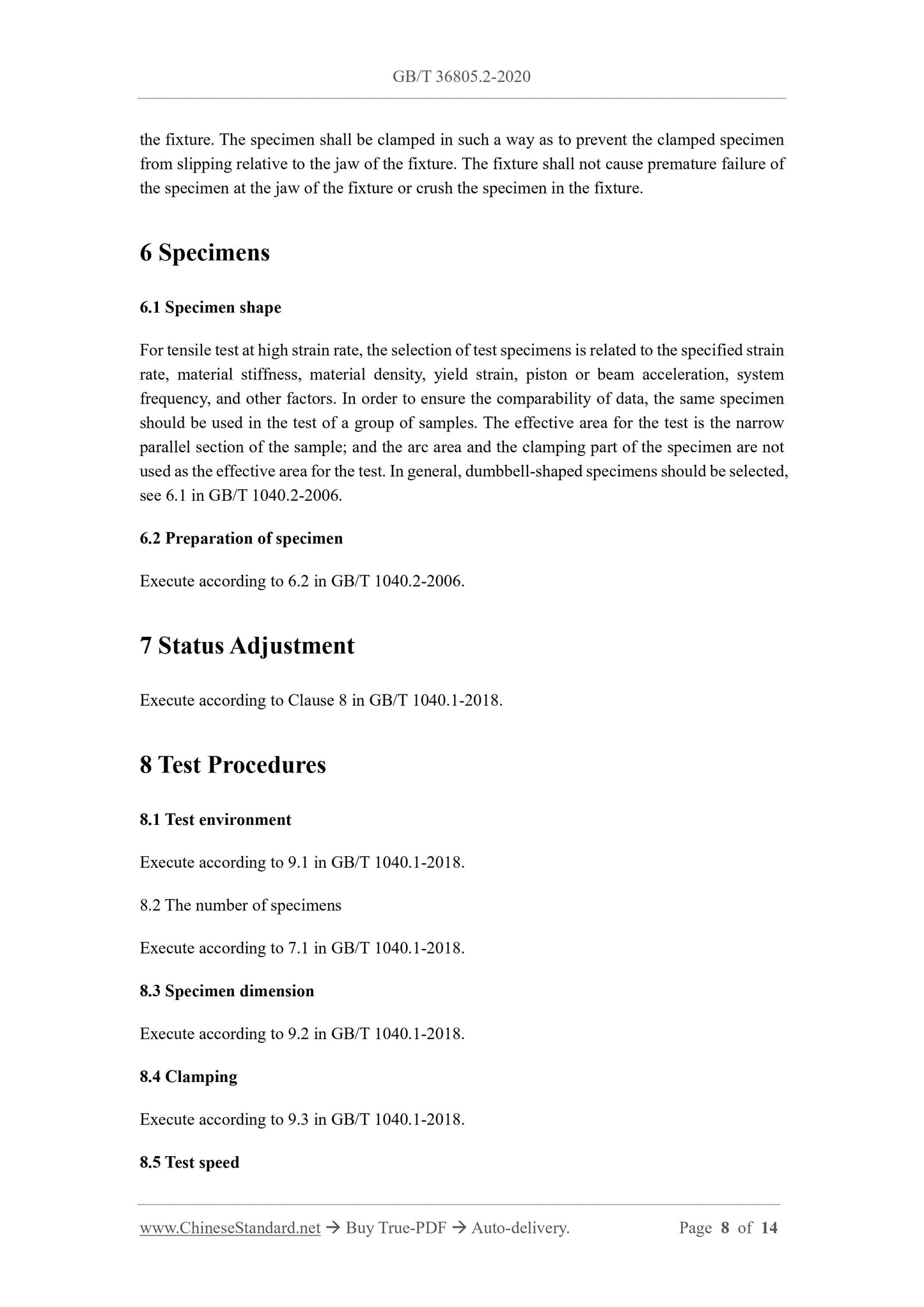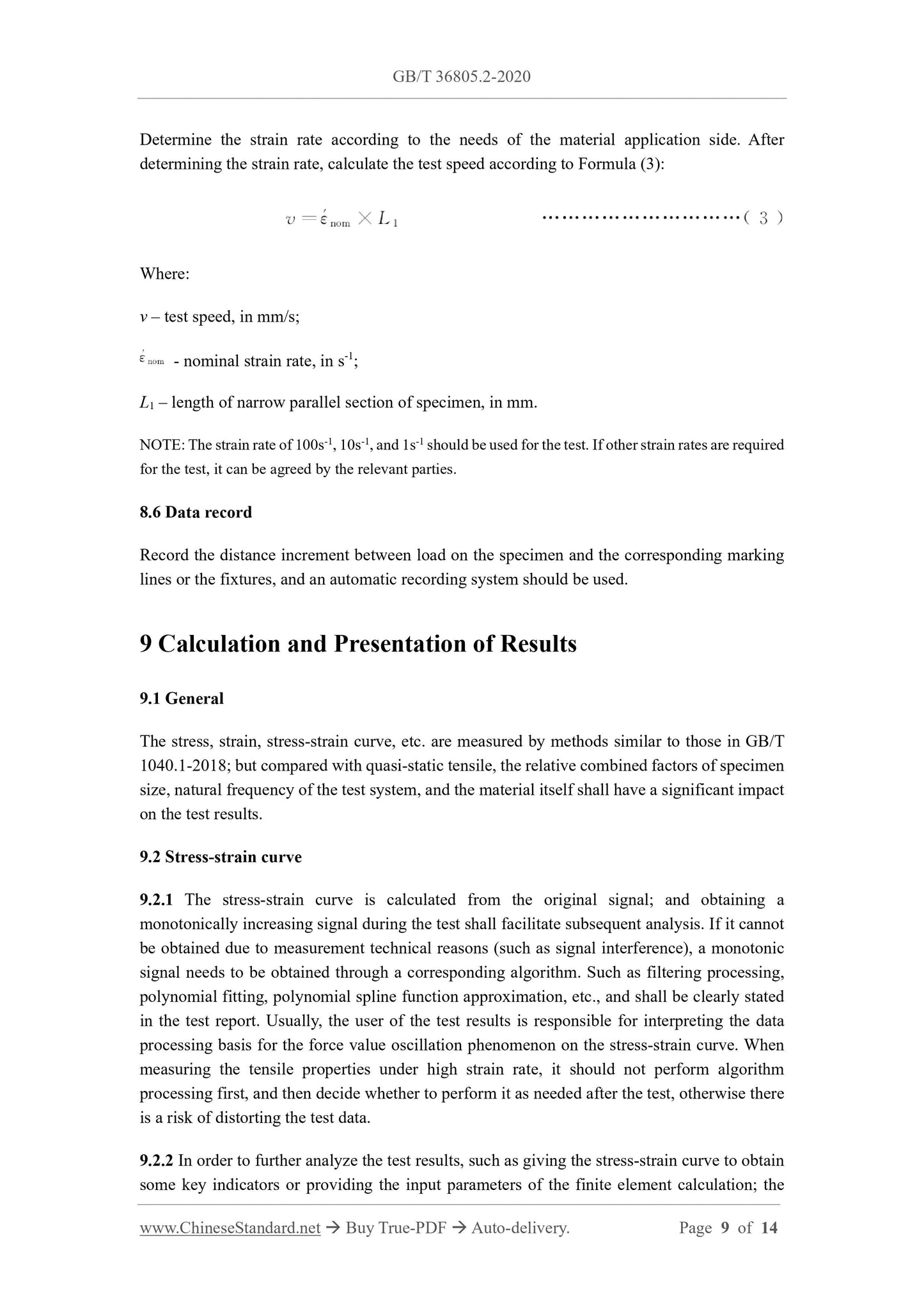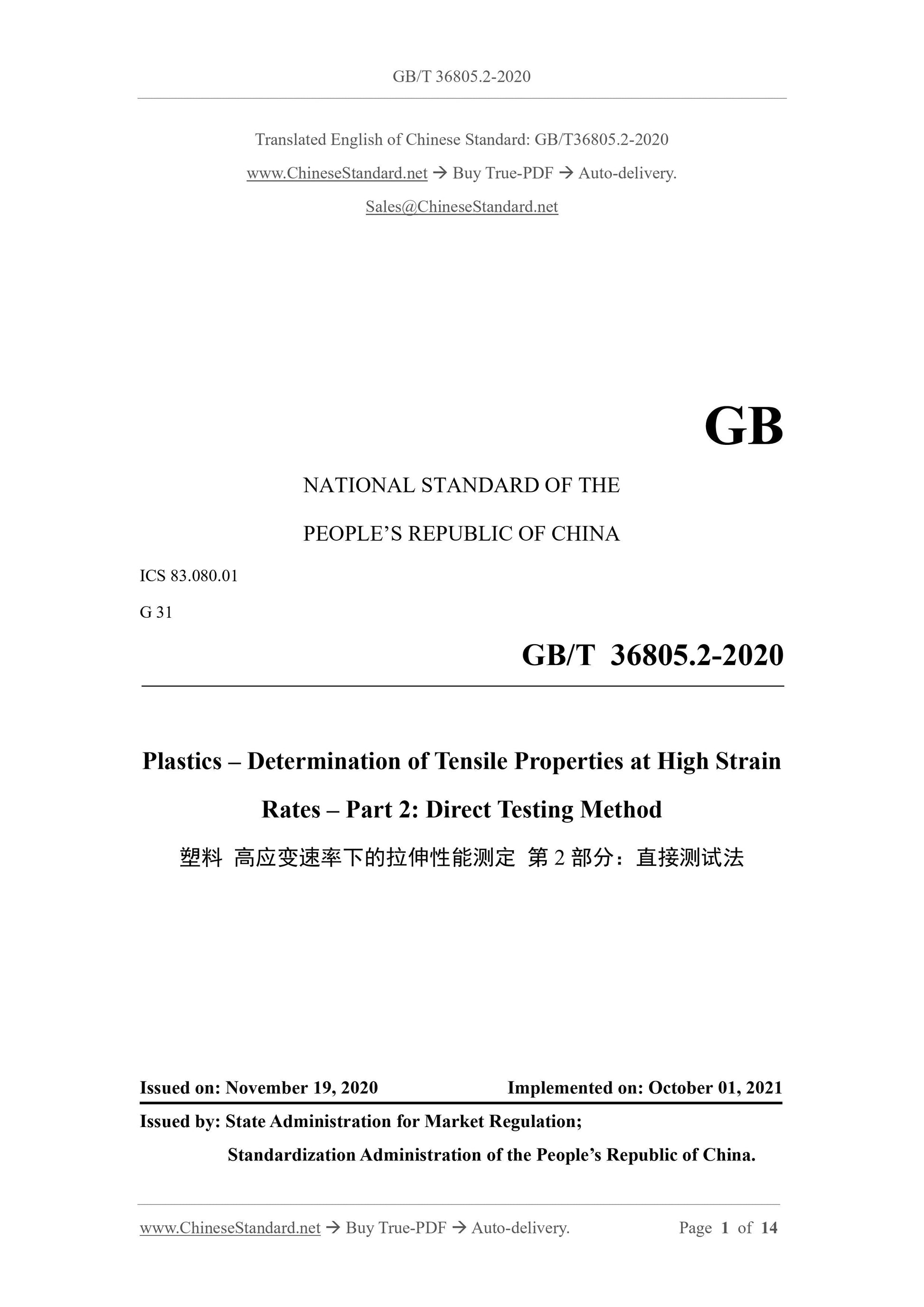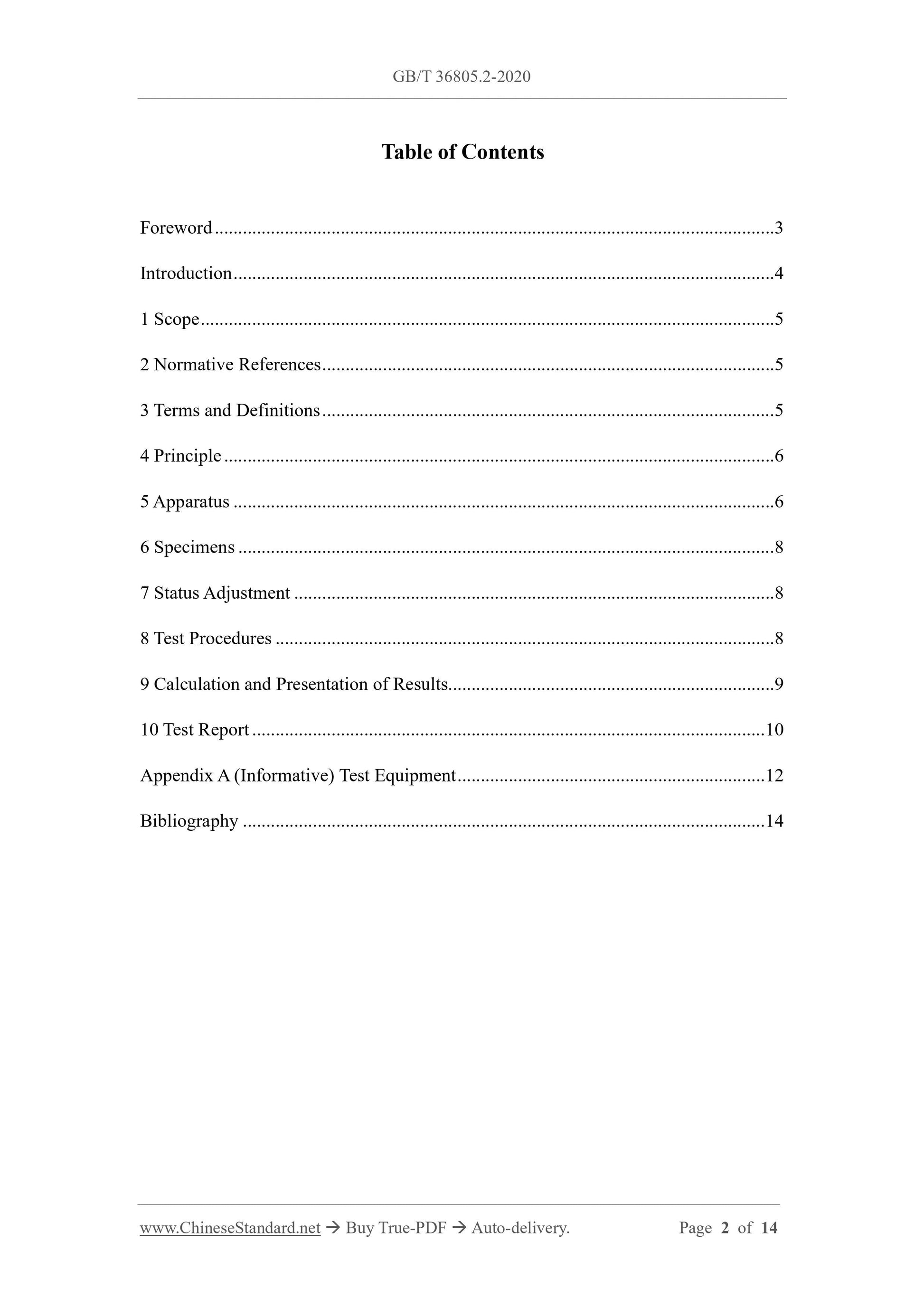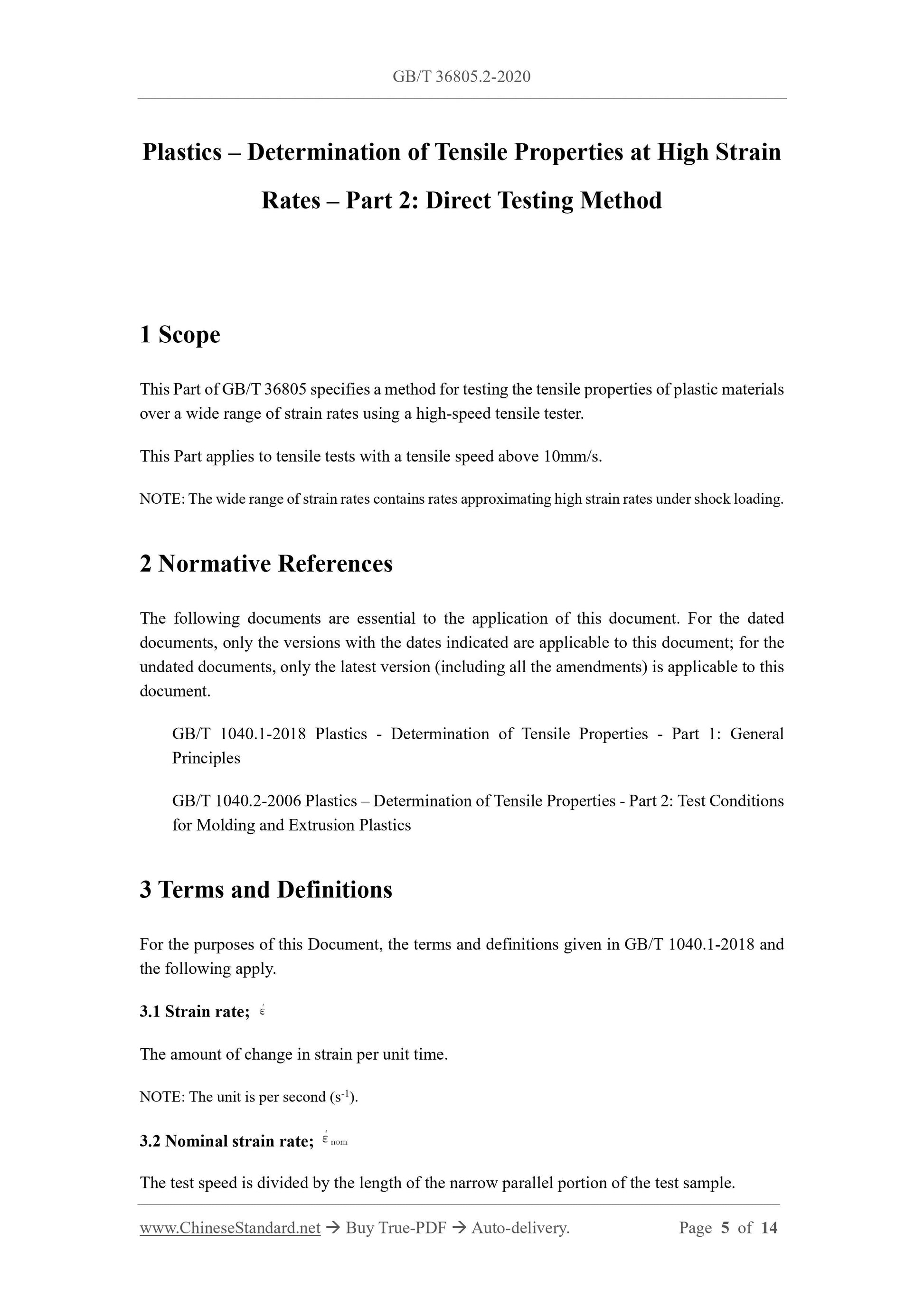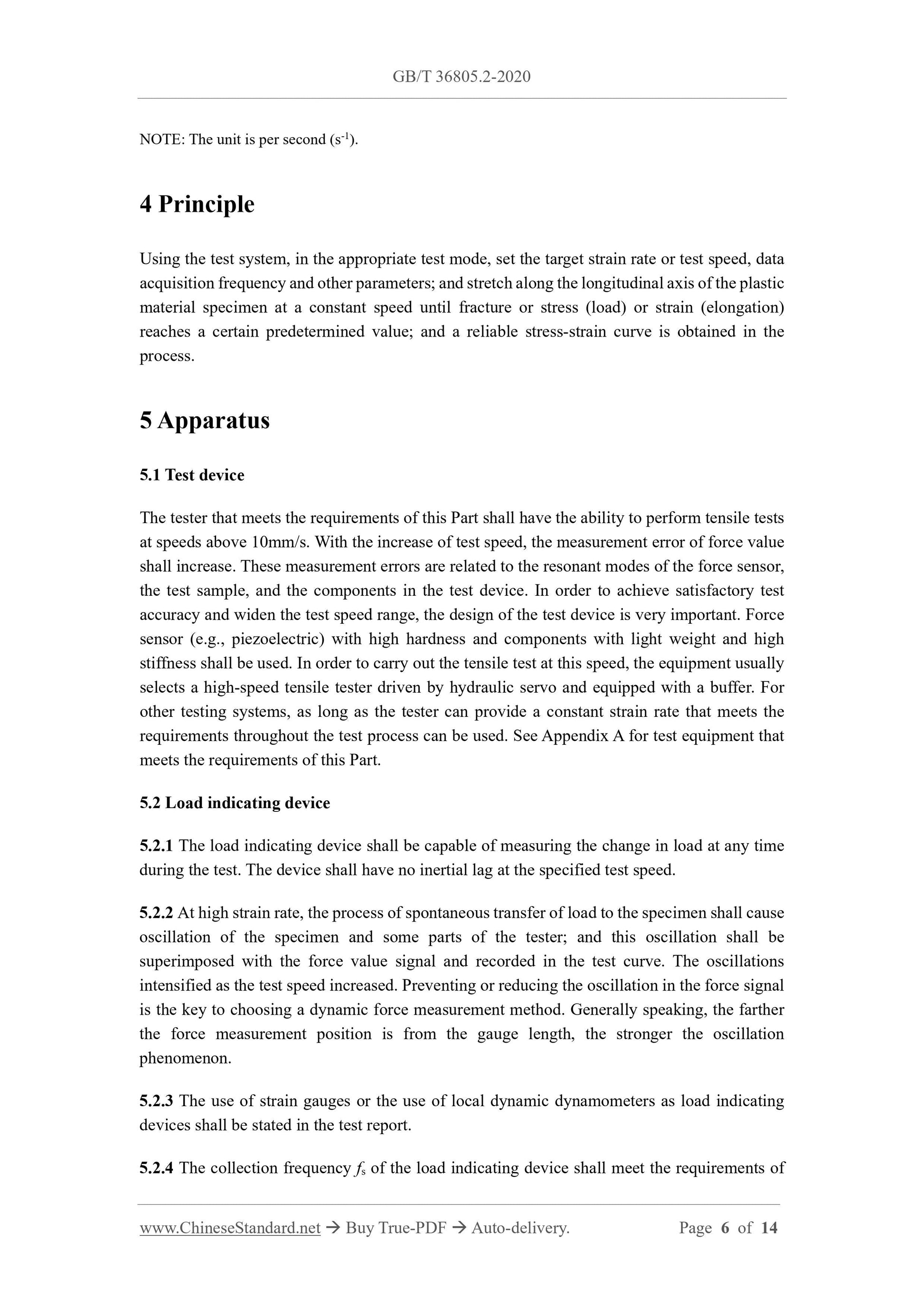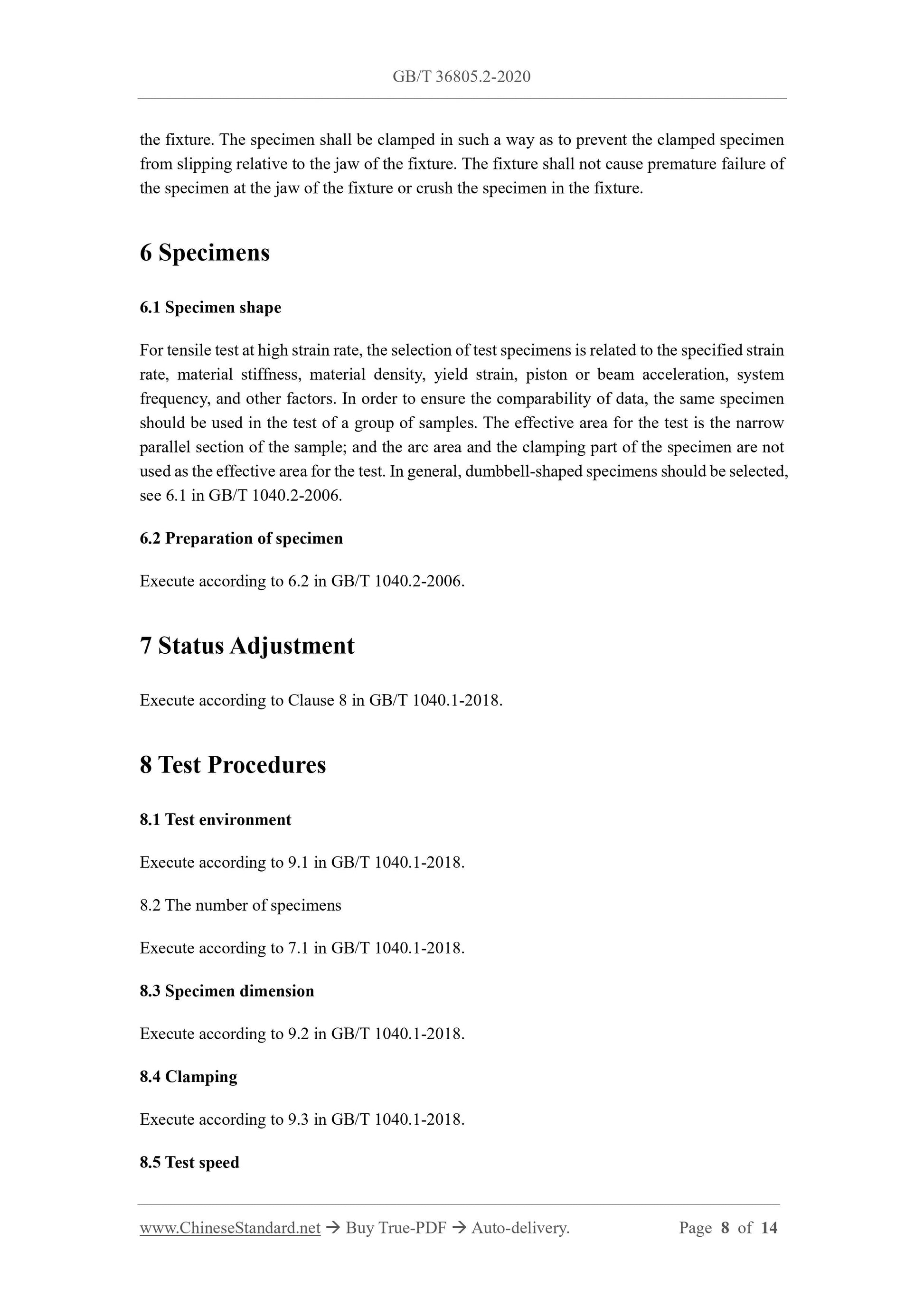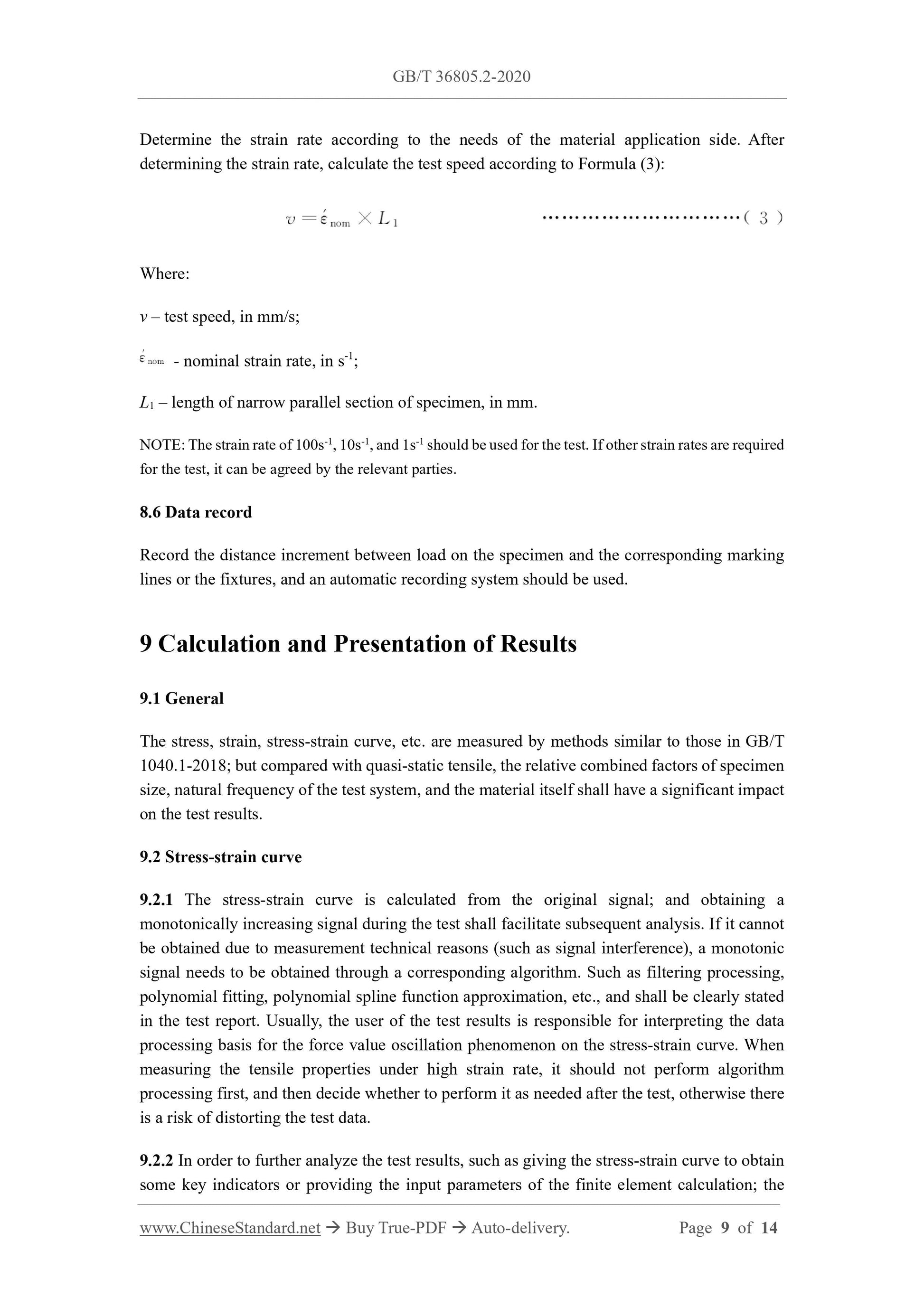1
/
of
6
www.ChineseStandard.us -- Field Test Asia Pte. Ltd.
GB/T 36805.2-2020 English PDF (GB/T36805.2-2020)
GB/T 36805.2-2020 English PDF (GB/T36805.2-2020)
Regular price
$170.00
Regular price
Sale price
$170.00
Unit price
/
per
Shipping calculated at checkout.
Couldn't load pickup availability
GB/T 36805.2-2020: Plastics - Determination of tensile properties at high strain rates - Part 2: Direct testing method
Delivery: 9 seconds. Download (& Email) true-PDF + Invoice.
Get Quotation: Click GB/T 36805.2-2020 (Self-service in 1-minute)
Historical versions (Master-website): GB/T 36805.2-2020
Preview True-PDF (Reload/Scroll-down if blank)
GB/T 36805.2-2020
NATIONAL STANDARD OF THE
PEOPLE’S REPUBLIC OF CHINA
ICS 83.080.01
G 31
Plastics – Determination of Tensile Properties at High Strain
Rates – Part 2: Direct Testing Method
ISSUED ON: NOVEMBER 19, 2020
IMPLEMENTED ON: OCTOBER 01, 2021
Issued by: State Administration for Market Regulation;
Standardization Administration of the People’s Republic of China.
Table of Contents
Foreword ... 3
Introduction ... 4
1 Scope ... 5
2 Normative References ... 5
3 Terms and Definitions ... 5
4 Principle ... 6
5 Apparatus ... 6
6 Specimens ... 8
7 Status Adjustment ... 8
8 Test Procedures ... 8
9 Calculation and Presentation of Results... 9
10 Test Report ... 10
Appendix A (Informative) Test Equipment ... 12
Bibliography ... 14
Plastics – Determination of Tensile Properties at High Strain
Rates – Part 2: Direct Testing Method
1 Scope
This Part of GB/T 36805 specifies a method for testing the tensile properties of plastic materials
over a wide range of strain rates using a high-speed tensile tester.
This Part applies to tensile tests with a tensile speed above 10mm/s.
NOTE: The wide range of strain rates contains rates approximating high strain rates under shock loading.
2 Normative References
The following documents are essential to the application of this document. For the dated
documents, only the versions with the dates indicated are applicable to this document; for the
undated documents, only the latest version (including all the amendments) is applicable to this
document.
GB/T 1040.1-2018 Plastics - Determination of Tensile Properties - Part 1: General
Principles
GB/T 1040.2-2006 Plastics – Determination of Tensile Properties - Part 2: Test Conditions
for Molding and Extrusion Plastics
3 Terms and Definitions
For the purposes of this Document, the terms and definitions given in GB/T 1040.1-2018 and
the following apply.
3.1 Strain rate;
The amount of change in strain per unit time.
NOTE: The unit is per second (s-1).
3.2 Nominal strain rate;
The test speed is divided by the length of the narrow parallel portion of the test sample.
NOTE: The unit is per second (s-1).
4 Principle
Using the test system, in the appropriate test mode, set the target strain rate or test speed, data
acquisition frequency and other parameters; and stretch along the longitudinal axis of the plastic
material specimen at a constant speed until fracture or stress (load) or strain (elongation)
reaches a certain predetermined value; and a reliable stress-strain curve is obtained in the
process.
5 Apparatus
5.1 Test device
The tester that meets the requirements of this Part shall have the ability to perform tensile tests
at speeds above 10mm/s. With the increase of test speed, the measurement error of force value
shall increase. These measurement errors are related to the resonant modes of the force sensor,
the test sample, and the components in the test device. In order to achieve satisfactory test
accuracy and widen the test speed range, the design of the test device is very important. Force
sensor (e.g., piezoelectric) with high hardness and components with light weight and high
stiffness shall be used. In order to carry out the tensile test at this speed, the equipment usually
selects a high-speed tensile tester driven by hydraulic servo and equipped with a buffer. For
other testing systems, as long as the tester can provide a constant strain rate that meets the
requirements throughout the test process can be used. See Appendix A for test equipment that
meets the requirements of this Part.
5.2 Load indicating device
5.2.1 The load indicating device shall be capable of measuring the change in load at any time
during the test. The device shall have no inertial lag at the specified test speed.
5.2.2 At high strain rate, the process of spontaneous transfer of load to the specimen shall cause
oscillation of the specimen and some parts of the tester; and this oscillation shall be
superimposed with the force value signal and recorded in the test curve. The oscillations
intensified as the test speed increased. Preventing or reducing the oscillation in the force signal
is the key to choosing a dynamic force measurement method. Generally speaking, the farther
the force measurement position is from the gauge length, the stronger the oscillation
phenomenon.
5.2.3 The use of strain gauges or the use of local dynamic dynamometers as load indicating
devices shall be stated in the test report.
5.2.4 The collection frequency fs of the load indicating device shall meet the requirements of
the fixture. The specimen shall be clamped in such a way as to prevent the clamped specimen
from slipping relative to the jaw of the fixture. The fixture shall not cause premature failure of
the specimen at the jaw of the fixture or crush the specimen in the fixture.
6 Specimens
6.1 Specimen shape
For tensile test at high strain rate, the selection of test specimens is related to the specified strain
rate, material stiffness, material density, yield strain, piston or beam acceleration, system
frequency, and other factors. In order to ensure the comparability of data, the same specimen
should be used in the test of a group of samples. The effective area for the test is the narrow
parallel section of the sample; and the arc area and the clamping part of the specimen are not
used as the effective area for the test. In general, dumbbell-shaped specimens should be selected,
see 6.1 in GB/T 1040.2-2006.
6.2 Preparation of specimen
Execute according to 6.2 in GB/T 1040.2-2006.
7 Status Adjustment
Execute according to Clause 8 in GB/T 1040.1-2018.
8 Test Procedures
8.1 Test environment
Execute according to 9.1 in GB/T 1040.1-2018.
8.2 The number of specimens
Execute according to 7.1 in GB/T 1040.1-2018.
8.3 Specimen dimension
Execute according to 9.2 in GB/T 1040.1-2018.
8.4 Clamping
Execute according to 9.3 in GB/T 1040.1-2018.
8.5 Test speed
Determine the strain rate according to the needs of the material application side. After
determining the strain rate, calculate the test speed according to Formula (3):
Where:
v – test speed, in mm/s;
- nominal strain rate, in s-1;
L1 – length of narrow parallel section of specimen, in mm.
NOTE: The strain rate of 100s-1, 10s-1, and 1s-1 should be used for the test. If other strain rates are required
for the test, it can be agreed by the relevant parties.
8.6 Data record
Record the distance increment between load on the specimen and the corresponding marking
lines or the fixtures, and an automatic recording system should be used.
9 Calculation and Presentation of Results
9.1 General
The stress, strain, stress-strain curve, etc. are measured by methods similar to those in GB/T
1040.1-2018; but compared with quasi-static tensile, the relative combined factors of specimen
size, natural frequency of the test system, and the material itself shall have a significant impact
on the test results.
9.2 Stress-strain curve
9.2.1 The stress-strain curve is calculated from the original signal; and obtaining a
monotonically increasing signal during the test shall facilitate subsequent analysis. If it cannot
be obtained due to measurement technical reasons (such as signal interference), a monotonic
signal needs to be obtained through a corresponding algorithm. Such as filtering processing,
polynomial fitting, polynomial spline function approximation, etc., and shall be clearly stated
in the test report. Usually, the user of the test results is responsible for interpreting the data
processing basis for the force value oscillation phenomenon on the stress-strain curve. When
measuring the tensile properties under high strain rate, it should not perform algorithm
processing first, and then decide whether to perform it as needed after the test, otherwise there
is a risk of distorting the test data.
9.2.2 In order to further analyze the test results, such as giving the stress-strain curve to obtain
some key indicators or providing the input parameters of the finite element calculation; the
GB/T 36805.2-2020
NATIONAL STANDARD OF THE
PEOPLE’S REPUBLIC OF CHINA
ICS 83.080.01
G 31
Plastics – Determination of Tensile Properties at High Strain
Rates – Part 2: Direct Testing Method
ISSUED ON: NOVEMBER 19, 2020
IMPLEMENTED ON: OCTOBER 01, 2021
Issued by: State Administration for Market Regulation;
Standardization Administration of the People’s Republic of China.
Table of Contents
Foreword ... 3
Introduction ... 4
1 Scope ... 5
2 Normative References ... 5
3 Terms and Definitions ... 5
4 Principle ... 6
5 Apparatus ... 6
6 Specimens ... 8
7 Status Adjustment ... 8
8 Test Procedures ... 8
9 Calculation and Presentation of Results... 9
10 Test Report ... 10
Appendix A (Informative) Test Equipment ... 12
Bibliography ... 14
Plastics – Determination of Tensile Properties at High Strain
Rates – Part 2: Direct Testing Method
1 Scope
This Part of GB/T 36805 specifies a method for testing the tensile properties of plastic materials
over a wide range of strain rates using a high-speed tensile tester.
This Part applies to tensile tests with a tensile speed above 10mm/s.
NOTE: The wide range of strain rates contains rates approximating high strain rates under shock loading.
2 Normative References
The following documents are essential to the application of this document. For the dated
documents, only the versions with the dates indicated are applicable to this document; for the
undated documents, only the latest version (including all the amendments) is applicable to this
document.
GB/T 1040.1-2018 Plastics - Determination of Tensile Properties - Part 1: General
Principles
GB/T 1040.2-2006 Plastics – Determination of Tensile Properties - Part 2: Test Conditions
for Molding and Extrusion Plastics
3 Terms and Definitions
For the purposes of this Document, the terms and definitions given in GB/T 1040.1-2018 and
the following apply.
3.1 Strain rate;
The amount of change in strain per unit time.
NOTE: The unit is per second (s-1).
3.2 Nominal strain rate;
The test speed is divided by the length of the narrow parallel portion of the test sample.
NOTE: The unit is per second (s-1).
4 Principle
Using the test system, in the appropriate test mode, set the target strain rate or test speed, data
acquisition frequency and other parameters; and stretch along the longitudinal axis of the plastic
material specimen at a constant speed until fracture or stress (load) or strain (elongation)
reaches a certain predetermined value; and a reliable stress-strain curve is obtained in the
process.
5 Apparatus
5.1 Test device
The tester that meets the requirements of this Part shall have the ability to perform tensile tests
at speeds above 10mm/s. With the increase of test speed, the measurement error of force value
shall increase. These measurement errors are related to the resonant modes of the force sensor,
the test sample, and the components in the test device. In order to achieve satisfactory test
accuracy and widen the test speed range, the design of the test device is very important. Force
sensor (e.g., piezoelectric) with high hardness and components with light weight and high
stiffness shall be used. In order to carry out the tensile test at this speed, the equipment usually
selects a high-speed tensile tester driven by hydraulic servo and equipped with a buffer. For
other testing systems, as long as the tester can provide a constant strain rate that meets the
requirements throughout the test process can be used. See Appendix A for test equipment that
meets the requirements of this Part.
5.2 Load indicating device
5.2.1 The load indicating device shall be capable of measuring the change in load at any time
during the test. The device shall have no inertial lag at the specified test speed.
5.2.2 At high strain rate, the process of spontaneous transfer of load to the specimen shall cause
oscillation of the specimen and some parts of the tester; and this oscillation shall be
superimposed with the force value signal and recorded in the test curve. The oscillations
intensified as the test speed increased. Preventing or reducing the oscillation in the force signal
is the key to choosing a dynamic force measurement method. Generally speaking, the farther
the force measurement position is from the gauge length, the stronger the oscillation
phenomenon.
5.2.3 The use of strain gauges or the use of local dynamic dynamometers as load indicating
devices shall be stated in the test report.
5.2.4 The collection frequency fs of the load indicating device shall meet the requirements of
the fixture. The specimen shall be clamped in such a way as to prevent the clamped specimen
from slipping relative to the jaw of the fixture. The fixture shall not cause premature failure of
the specimen at the jaw of the fixture or crush the specimen in the fixture.
6 Specimens
6.1 Specimen shape
For tensile test at high strain rate, the selection of test specimens is related to the specified strain
rate, material stiffness, material density, yield strain, piston or beam acceleration, system
frequency, and other factors. In order to ensure the comparability of data, the same specimen
should be used in the test of a group of samples. The effective area for the test is the narrow
parallel section of the sample; and the arc area and the clamping part of the specimen are not
used as the effective area for the test. In general, dumbbell-shaped specimens should be selected,
see 6.1 in GB/T 1040.2-2006.
6.2 Preparation of specimen
Execute according to 6.2 in GB/T 1040.2-2006.
7 Status Adjustment
Execute according to Clause 8 in GB/T 1040.1-2018.
8 Test Procedures
8.1 Test environment
Execute according to 9.1 in GB/T 1040.1-2018.
8.2 The number of specimens
Execute according to 7.1 in GB/T 1040.1-2018.
8.3 Specimen dimension
Execute according...
Delivery: 9 seconds. Download (& Email) true-PDF + Invoice.
Get Quotation: Click GB/T 36805.2-2020 (Self-service in 1-minute)
Historical versions (Master-website): GB/T 36805.2-2020
Preview True-PDF (Reload/Scroll-down if blank)
GB/T 36805.2-2020
NATIONAL STANDARD OF THE
PEOPLE’S REPUBLIC OF CHINA
ICS 83.080.01
G 31
Plastics – Determination of Tensile Properties at High Strain
Rates – Part 2: Direct Testing Method
ISSUED ON: NOVEMBER 19, 2020
IMPLEMENTED ON: OCTOBER 01, 2021
Issued by: State Administration for Market Regulation;
Standardization Administration of the People’s Republic of China.
Table of Contents
Foreword ... 3
Introduction ... 4
1 Scope ... 5
2 Normative References ... 5
3 Terms and Definitions ... 5
4 Principle ... 6
5 Apparatus ... 6
6 Specimens ... 8
7 Status Adjustment ... 8
8 Test Procedures ... 8
9 Calculation and Presentation of Results... 9
10 Test Report ... 10
Appendix A (Informative) Test Equipment ... 12
Bibliography ... 14
Plastics – Determination of Tensile Properties at High Strain
Rates – Part 2: Direct Testing Method
1 Scope
This Part of GB/T 36805 specifies a method for testing the tensile properties of plastic materials
over a wide range of strain rates using a high-speed tensile tester.
This Part applies to tensile tests with a tensile speed above 10mm/s.
NOTE: The wide range of strain rates contains rates approximating high strain rates under shock loading.
2 Normative References
The following documents are essential to the application of this document. For the dated
documents, only the versions with the dates indicated are applicable to this document; for the
undated documents, only the latest version (including all the amendments) is applicable to this
document.
GB/T 1040.1-2018 Plastics - Determination of Tensile Properties - Part 1: General
Principles
GB/T 1040.2-2006 Plastics – Determination of Tensile Properties - Part 2: Test Conditions
for Molding and Extrusion Plastics
3 Terms and Definitions
For the purposes of this Document, the terms and definitions given in GB/T 1040.1-2018 and
the following apply.
3.1 Strain rate;
The amount of change in strain per unit time.
NOTE: The unit is per second (s-1).
3.2 Nominal strain rate;
The test speed is divided by the length of the narrow parallel portion of the test sample.
NOTE: The unit is per second (s-1).
4 Principle
Using the test system, in the appropriate test mode, set the target strain rate or test speed, data
acquisition frequency and other parameters; and stretch along the longitudinal axis of the plastic
material specimen at a constant speed until fracture or stress (load) or strain (elongation)
reaches a certain predetermined value; and a reliable stress-strain curve is obtained in the
process.
5 Apparatus
5.1 Test device
The tester that meets the requirements of this Part shall have the ability to perform tensile tests
at speeds above 10mm/s. With the increase of test speed, the measurement error of force value
shall increase. These measurement errors are related to the resonant modes of the force sensor,
the test sample, and the components in the test device. In order to achieve satisfactory test
accuracy and widen the test speed range, the design of the test device is very important. Force
sensor (e.g., piezoelectric) with high hardness and components with light weight and high
stiffness shall be used. In order to carry out the tensile test at this speed, the equipment usually
selects a high-speed tensile tester driven by hydraulic servo and equipped with a buffer. For
other testing systems, as long as the tester can provide a constant strain rate that meets the
requirements throughout the test process can be used. See Appendix A for test equipment that
meets the requirements of this Part.
5.2 Load indicating device
5.2.1 The load indicating device shall be capable of measuring the change in load at any time
during the test. The device shall have no inertial lag at the specified test speed.
5.2.2 At high strain rate, the process of spontaneous transfer of load to the specimen shall cause
oscillation of the specimen and some parts of the tester; and this oscillation shall be
superimposed with the force value signal and recorded in the test curve. The oscillations
intensified as the test speed increased. Preventing or reducing the oscillation in the force signal
is the key to choosing a dynamic force measurement method. Generally speaking, the farther
the force measurement position is from the gauge length, the stronger the oscillation
phenomenon.
5.2.3 The use of strain gauges or the use of local dynamic dynamometers as load indicating
devices shall be stated in the test report.
5.2.4 The collection frequency fs of the load indicating device shall meet the requirements of
the fixture. The specimen shall be clamped in such a way as to prevent the clamped specimen
from slipping relative to the jaw of the fixture. The fixture shall not cause premature failure of
the specimen at the jaw of the fixture or crush the specimen in the fixture.
6 Specimens
6.1 Specimen shape
For tensile test at high strain rate, the selection of test specimens is related to the specified strain
rate, material stiffness, material density, yield strain, piston or beam acceleration, system
frequency, and other factors. In order to ensure the comparability of data, the same specimen
should be used in the test of a group of samples. The effective area for the test is the narrow
parallel section of the sample; and the arc area and the clamping part of the specimen are not
used as the effective area for the test. In general, dumbbell-shaped specimens should be selected,
see 6.1 in GB/T 1040.2-2006.
6.2 Preparation of specimen
Execute according to 6.2 in GB/T 1040.2-2006.
7 Status Adjustment
Execute according to Clause 8 in GB/T 1040.1-2018.
8 Test Procedures
8.1 Test environment
Execute according to 9.1 in GB/T 1040.1-2018.
8.2 The number of specimens
Execute according to 7.1 in GB/T 1040.1-2018.
8.3 Specimen dimension
Execute according to 9.2 in GB/T 1040.1-2018.
8.4 Clamping
Execute according to 9.3 in GB/T 1040.1-2018.
8.5 Test speed
Determine the strain rate according to the needs of the material application side. After
determining the strain rate, calculate the test speed according to Formula (3):
Where:
v – test speed, in mm/s;
- nominal strain rate, in s-1;
L1 – length of narrow parallel section of specimen, in mm.
NOTE: The strain rate of 100s-1, 10s-1, and 1s-1 should be used for the test. If other strain rates are required
for the test, it can be agreed by the relevant parties.
8.6 Data record
Record the distance increment between load on the specimen and the corresponding marking
lines or the fixtures, and an automatic recording system should be used.
9 Calculation and Presentation of Results
9.1 General
The stress, strain, stress-strain curve, etc. are measured by methods similar to those in GB/T
1040.1-2018; but compared with quasi-static tensile, the relative combined factors of specimen
size, natural frequency of the test system, and the material itself shall have a significant impact
on the test results.
9.2 Stress-strain curve
9.2.1 The stress-strain curve is calculated from the original signal; and obtaining a
monotonically increasing signal during the test shall facilitate subsequent analysis. If it cannot
be obtained due to measurement technical reasons (such as signal interference), a monotonic
signal needs to be obtained through a corresponding algorithm. Such as filtering processing,
polynomial fitting, polynomial spline function approximation, etc., and shall be clearly stated
in the test report. Usually, the user of the test results is responsible for interpreting the data
processing basis for the force value oscillation phenomenon on the stress-strain curve. When
measuring the tensile properties under high strain rate, it should not perform algorithm
processing first, and then decide whether to perform it as needed after the test, otherwise there
is a risk of distorting the test data.
9.2.2 In order to further analyze the test results, such as giving the stress-strain curve to obtain
some key indicators or providing the input parameters of the finite element calculation; the
GB/T 36805.2-2020
NATIONAL STANDARD OF THE
PEOPLE’S REPUBLIC OF CHINA
ICS 83.080.01
G 31
Plastics – Determination of Tensile Properties at High Strain
Rates – Part 2: Direct Testing Method
ISSUED ON: NOVEMBER 19, 2020
IMPLEMENTED ON: OCTOBER 01, 2021
Issued by: State Administration for Market Regulation;
Standardization Administration of the People’s Republic of China.
Table of Contents
Foreword ... 3
Introduction ... 4
1 Scope ... 5
2 Normative References ... 5
3 Terms and Definitions ... 5
4 Principle ... 6
5 Apparatus ... 6
6 Specimens ... 8
7 Status Adjustment ... 8
8 Test Procedures ... 8
9 Calculation and Presentation of Results... 9
10 Test Report ... 10
Appendix A (Informative) Test Equipment ... 12
Bibliography ... 14
Plastics – Determination of Tensile Properties at High Strain
Rates – Part 2: Direct Testing Method
1 Scope
This Part of GB/T 36805 specifies a method for testing the tensile properties of plastic materials
over a wide range of strain rates using a high-speed tensile tester.
This Part applies to tensile tests with a tensile speed above 10mm/s.
NOTE: The wide range of strain rates contains rates approximating high strain rates under shock loading.
2 Normative References
The following documents are essential to the application of this document. For the dated
documents, only the versions with the dates indicated are applicable to this document; for the
undated documents, only the latest version (including all the amendments) is applicable to this
document.
GB/T 1040.1-2018 Plastics - Determination of Tensile Properties - Part 1: General
Principles
GB/T 1040.2-2006 Plastics – Determination of Tensile Properties - Part 2: Test Conditions
for Molding and Extrusion Plastics
3 Terms and Definitions
For the purposes of this Document, the terms and definitions given in GB/T 1040.1-2018 and
the following apply.
3.1 Strain rate;
The amount of change in strain per unit time.
NOTE: The unit is per second (s-1).
3.2 Nominal strain rate;
The test speed is divided by the length of the narrow parallel portion of the test sample.
NOTE: The unit is per second (s-1).
4 Principle
Using the test system, in the appropriate test mode, set the target strain rate or test speed, data
acquisition frequency and other parameters; and stretch along the longitudinal axis of the plastic
material specimen at a constant speed until fracture or stress (load) or strain (elongation)
reaches a certain predetermined value; and a reliable stress-strain curve is obtained in the
process.
5 Apparatus
5.1 Test device
The tester that meets the requirements of this Part shall have the ability to perform tensile tests
at speeds above 10mm/s. With the increase of test speed, the measurement error of force value
shall increase. These measurement errors are related to the resonant modes of the force sensor,
the test sample, and the components in the test device. In order to achieve satisfactory test
accuracy and widen the test speed range, the design of the test device is very important. Force
sensor (e.g., piezoelectric) with high hardness and components with light weight and high
stiffness shall be used. In order to carry out the tensile test at this speed, the equipment usually
selects a high-speed tensile tester driven by hydraulic servo and equipped with a buffer. For
other testing systems, as long as the tester can provide a constant strain rate that meets the
requirements throughout the test process can be used. See Appendix A for test equipment that
meets the requirements of this Part.
5.2 Load indicating device
5.2.1 The load indicating device shall be capable of measuring the change in load at any time
during the test. The device shall have no inertial lag at the specified test speed.
5.2.2 At high strain rate, the process of spontaneous transfer of load to the specimen shall cause
oscillation of the specimen and some parts of the tester; and this oscillation shall be
superimposed with the force value signal and recorded in the test curve. The oscillations
intensified as the test speed increased. Preventing or reducing the oscillation in the force signal
is the key to choosing a dynamic force measurement method. Generally speaking, the farther
the force measurement position is from the gauge length, the stronger the oscillation
phenomenon.
5.2.3 The use of strain gauges or the use of local dynamic dynamometers as load indicating
devices shall be stated in the test report.
5.2.4 The collection frequency fs of the load indicating device shall meet the requirements of
the fixture. The specimen shall be clamped in such a way as to prevent the clamped specimen
from slipping relative to the jaw of the fixture. The fixture shall not cause premature failure of
the specimen at the jaw of the fixture or crush the specimen in the fixture.
6 Specimens
6.1 Specimen shape
For tensile test at high strain rate, the selection of test specimens is related to the specified strain
rate, material stiffness, material density, yield strain, piston or beam acceleration, system
frequency, and other factors. In order to ensure the comparability of data, the same specimen
should be used in the test of a group of samples. The effective area for the test is the narrow
parallel section of the sample; and the arc area and the clamping part of the specimen are not
used as the effective area for the test. In general, dumbbell-shaped specimens should be selected,
see 6.1 in GB/T 1040.2-2006.
6.2 Preparation of specimen
Execute according to 6.2 in GB/T 1040.2-2006.
7 Status Adjustment
Execute according to Clause 8 in GB/T 1040.1-2018.
8 Test Procedures
8.1 Test environment
Execute according to 9.1 in GB/T 1040.1-2018.
8.2 The number of specimens
Execute according to 7.1 in GB/T 1040.1-2018.
8.3 Specimen dimension
Execute according...
Share
